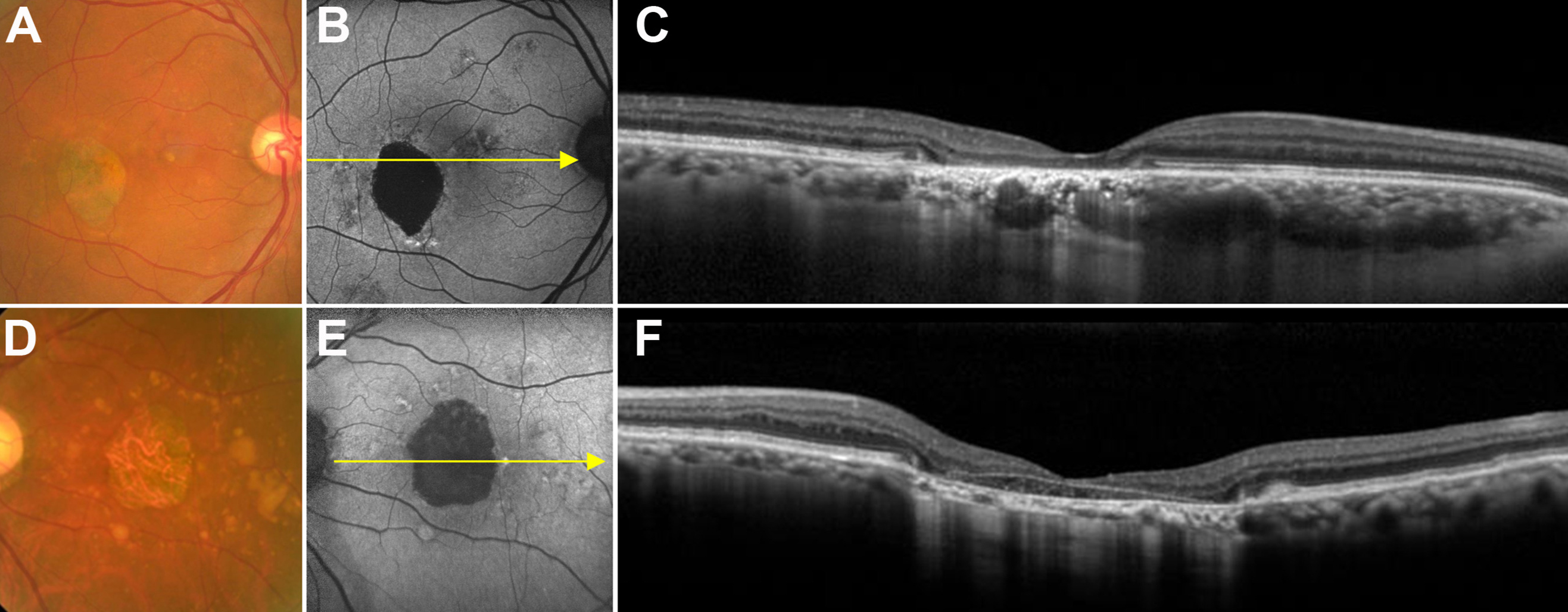The relatively new category of conditions called pachychoroid spectrum disorders is fertile ground for research, as it comprises an array of overlapping presentations in need of more precise characterization. At the same time, geographic atrophy (GA) research is gaining in prominence in the wake of two drug approvals for the condition. A recent paper in published in Ophthalmology Science ties together both of these trends with new findings on each.
 |
| Conventional drusen-related GA observed in Asian populations was similar to that observed in Caucasian populations. These images from the study show multimodal imaging of pachychoroid GA (A–C) and conventional GA (D–F). Photo: Sato Y, et al. Ophthalmol Sci. April 9, 2024. Click image to enlarge. |
Some GA patients present with features of pachychoroid, known as pachychoroid GA. Teasing out pachychoroid GA from drusen-related conventional GA is of value clinically and as a matter of scientific understanding. The new study in question examined a Japanese cohort to reveal whether pachychoroid GA can account for the unique clinical characteristics of Asian GA and to clarify whether drusen-related conventional GA has the same features as GA in Caucasian populations. The Japanese researchers found that that the progression rate of pachychoroid GA, adjusted for age and baseline GA area, was significantly lower than that of conventional GA. Some characteristics of GA in Japanese population differ from those in Caucasian populations, which may be due to the inclusion of pachychoroid GA.
A total of 173 eyes from 173 patients (38 eyes with pachychoroid GA and 135 with conventional GA) from six university hospitals in Japan were included. All patients were 50 years old and older and with fundus autofluorescence (FAF) images having analyzable image quality. A total of 101 eyes (22 with pachychoroid GA and 79 with conventional GA) were included in the follow-up group. The studied eyes were classified as having pachychoroid or conventional GA; the former was diagnosed if the eye had features of pachychoroid and no drusen.
Within the Japanese cohort, 38 (22.0 %) patients were classified into the pachychoroid GA group. The pachychoroid GA group was significantly younger (mean age 70.3 vs. 78.7), more male-dominant (89.5% vs. 55.6 %) and had better BCVA (0.15 logMAR vs. 0.40 logMAR), thicker choroid (312.4µm vs. 161.6μm), higher rate of unifocal GA type (94.7% vs. 49.6%) and smaller GA area (0.59mm2 vs. 3.76mm2) than the conventional GA group. In the follow-up group, the mean GA progression rate was significantly lower in the pachychoroid GA group than in the conventional GA group (0.11mm/year vs 0.27mm/year). In the Japanese cohort, the characteristics of conventional GA were more similar to those reported in Caucasian populations. This includes age, bilateral GA rate, multifocality rate and reticular pseudodrusen prevalence.
“While pachychoroid GA can also develop in Caucasian populations, the incidence of this disease is likely to differ from that in Asian populations,” the researchers wrote in their paper. “Researchers should consider these differences in GA subtypes when considering interventions for GA.”
Sato Y, Ueda-Arakawa N, Takahashi A, et al. Clinical characteristics and progression of pachychoroid and conventional geographic atrophy. Ophthalmol Sci. April 9, 2024. [Epub ahead of print]. |


